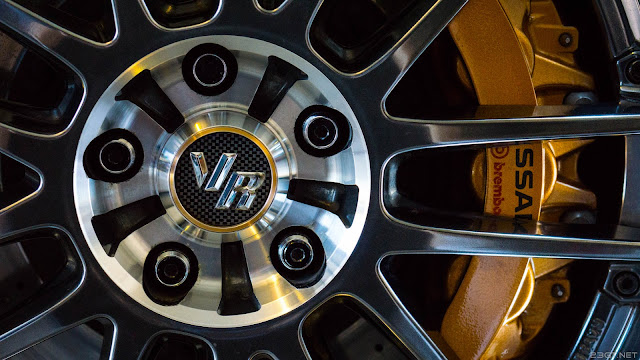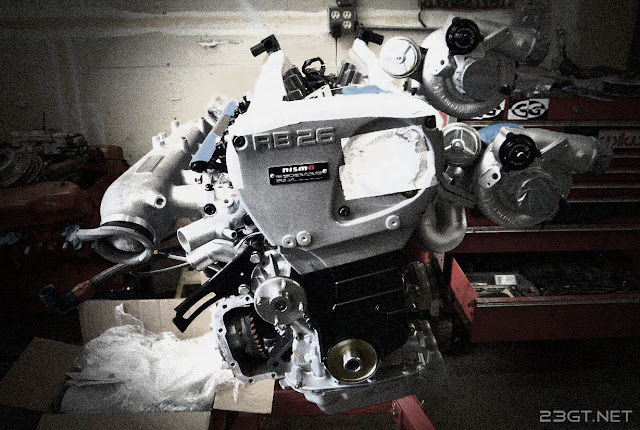R35 GT-R Maintenance Logs Part 3 - Brakes
The R35 GT-R is an extremely fast car,
especially if it's been extensively modified. Of course, any car that
can easily hit triple digits in the time it takes to read this
sentence needs to be able to come to a stop just as quickly 'cause
running into things is bad, you know? Thankfully Nissan equipped the
R35 with an extremely beefy brake setup.
No matter how good the brake system
however it'll need periodic maintenance to make sure it keeps
performing at its best. For my R35 the time had finally come for me
to replace the OEM brake pads and rotors it had come with.
 |
| The OEM front brake setup. |
It wasn't because the pads or the
rotors were worn out as you might assume. Instead it was because I
had experienced the huge flaw with the OEM brake setup – cracking
of the rotors. The R35 is a fairly heavy car and it puts a lot of
stress on its brake rotors. After enough heat cycles on track – or
even heavy street use - the stock rotors start to develop cracks in
the spots where they were cross-drilled. It's a common phenomenon but
certainly not something you want to ignore if you push your car
often. Let the cracks get too bad and you better like living life on
the edge because a rotor that spontaneously converts itself into
dozens of chunks of scrap metal does a piss poor job of stopping a
car. Before I took my GT-R out on track again the old rotors had to
go.
 |
| Well that doesn't look good... |
There are lots of good brake
replacement solutions out there for the R35 ranging from simple
replacement rotors and pads that reuse the stock rotor hats to full
big brake kits with carbon ceramic rotors, billet monoblock calipers,
and BIG, SHOUTY LOGOS that will lighten your car – and your
pocketbook – by huge amounts.
Speaking of lightening your pocketbook,
one good way of doing it without much gain is having a Nissan dealer
do your brake job with OEM parts. Nothing against Nissan dealers –
my local one's awesome btw – but some of the unscrupulous ones will take you to the
cleaners on parts pricing with some unsuspecting people being charged
7-8 grand for an R35 brake job. Those kinds of dealers make brothels
look like beacons of purity. Don't get taken for a ride by going
aftermarket for your brakes if you have an R35...and you'll have
money left over for the brothel.
I wanted a kit that was better than a
basic replacement setup but one that wouldn't break the bank.
Eventually I settled on a setup from RacingBrake that would not only
prevent me from having issues with cracking rotors again but it would
also give better braking AND reduce unsprung weight on all four
corners.
One of the upgrades from the 2009-2011
CBA cars to the later model year GT-Rs was an increase in the brake
rotor diameter from 380mm to 390mm. The kit I got included larger
rotors that matched the size of the later cars but also included
spacers to relocate the CBA calipers appropriately to fit them. The
larger rotors should help braking performance by increasing the swept
area of the pads but also should provide slightly more mass to
accommodate heat. Besides, bigger's always better right? Except with
tsunamis...and utility bills...and kidney stones...and stab wounds...
 |
| Bigger and cooler in both looks and performance. |
Another cool thing about the
RacingBrake kit was that it came with new forged aluminum hats
instead of having to reuse the stock steel ones. This upped the price
by quite a bit but in exchange it promised to cut unsprung weight in
all four corners. According to the stats published online the front
brakes should lose about two pounds in weight while the rears a
substantial five pounds. That may not sound like much but as anyone
well-versed in performance mods will readily tell you, losing
unsprung weight is far more valuable than reducing weight in any
other place on a car since it helps you accelerate faster, stop more
quickly, helps improve suspension performance, and returns that youthful luster to your skin (I may be lying about that last one). Another advantage
to the RacingBrake hats is their more open design that improves brake
cooling. And despite being aluminum they have an iron insert to allow
compatibility with the OEM parking brake so your car never rolls away and ends up on Youtube.
The new rotors, hats, and brake pads
plus Motul brake fluid and new stainless steel lines set me back just
under 3200 dollars. Just replacing the rotors and reusing the OEM
hats will save you a lot and if you're not planning on taking your
car to the track a good kit should cost you only about 1800 bucks. My
preference when replacing parts is to try and find something that
offers an appreciable advantage over the original parts though so I
made the decision to pay the extra for the lighter weight and higher
performing kit.
 |
| Bye bye cracks! |
Installation of a brake kit like this
isn't cheap of course and will typically cost you $400-700 on labor.
You could of course do it yourself but brakes are so critical that
you should only attempt this if you're sure of what you're doing.
I've done brake work before on my other cars but the R35 is on a
whole other level performance-wise so I opted to let a pro do it for
me. I haven't had a chance to test out the new kit on the track but
come back after Thanksgiving 'cause I'm planning on giving these bad
boys a proper baptism at Laguna Seca for R's Day!
The observant among you may have also
noticed another change in the pictures – I swapped lug nuts. That
may seem like a weird thing to change but the Volk Formula lug nuts I
used to have had a very annoying flaw. Unlike conventional lug nuts
that have a hexagonal shape or splined surface the Formula nuts have
a smooth outer surface and are turned using a heptagonal key that
slots inside the nut. To cover the heptagonal slot each nut has an
aluminum cover that screws into the end. Being aluminum however
they're easy to strip if some monkey – like at your local tire
place – doesn't take care in re-installing them into the steel lug
nuts. That's exactly what happened with a couple of mine and one was
bad enough that an EZ Out had to be used since the allen slot had
rounded off. Imagine if that happened and you had to change a tire or
wheel while a long way from the nearest shop. I'm sure you'd want to
shove those offending lug nuts up certain orifices of the tire guy
who ruined them especially seeing how pricey the Formula lug nuts
are.
To avoid future issues I decided to go
more conventional and switch to a set of simple Rays steel lug nuts.
Why go with steel again you might ask when aluminum nuts are
available and weigh less? Didn't I drone on about unsprung weight
being so important? Well, there's a simple reason for using steel:
Nissan specifies torquing lug nuts on the GT-R to 97 foot pounds and
aluminum nuts are typically rated to only about 80. Steel nuts can
handle the high torgue spec of the R35 and avoid any highly
embarrassing moments when your wheel decides it wants to go back to
the pits before you and the rest of the car decide to do so.
Hopefully that never happens to you. Drive safe!




Comments
Post a Comment